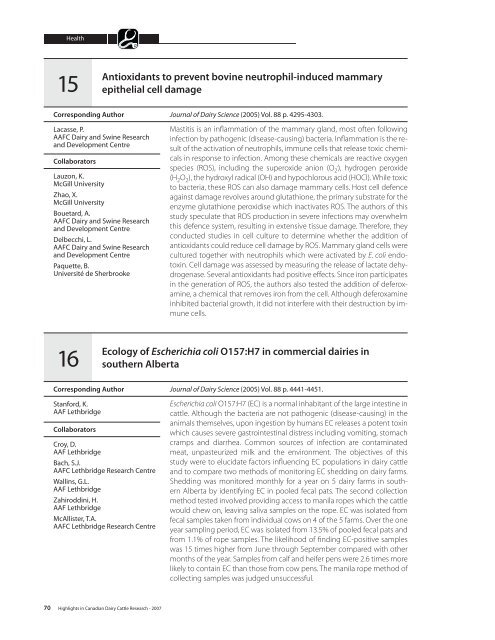A52-75-2007E.pdf - AgroMedia International Inc
A52-75-2007E.pdf - AgroMedia International Inc
A52-75-2007E.pdf - AgroMedia International Inc
Create successful ePaper yourself
Turn your PDF publications into a flip-book with our unique Google optimized e-Paper software.
Health15Antioxidants to prevent bovine neutrophil-induced mammaryepithelial cell damageCorresponding AuthorLacasse, P.AAFC Dairy and Swine Researchand Development CentreCollaboratorsLauzon, K.McGill UniversityZhao, X.McGill UniversityBouetard, A.AAFC Dairy and Swine Researchand Development CentreDelbecchi, L.AAFC Dairy and Swine Researchand Development CentrePaquette, B.Université de SherbrookeJournal of Dairy Science (2005) Vol. 88 p. 4295-4303.Mastitis is an inflammation of the mammary gland, most often followinginfection by pathogenic (disease-causing) bacteria. Inflammation is the resultof the activation of neutrophils, immune cells that release toxic chemicalsin response to infection. Among these chemicals are reactive oxygenspecies (ROS), including the superoxide anion (O 2 - ), hydrogen peroxide(H 2 O 2 ), the hydroxyl radical (OH) and hypochlorous acid (HOCl). While toxicto bacteria, these ROS can also damage mammary cells. Host cell defenceagainst damage revolves around glutathione, the primary substrate for theenzyme glutathione peroxidise which inactivates ROS. The authors of thisstudy speculate that ROS production in severe infections may overwhelmthis defence system, resulting in extensive tissue damage. Therefore, theyconducted studies in cell culture to determine whether the addition ofantioxidants could reduce cell damage by ROS. Mammary gland cells werecultured together with neutrophils which were activated by E. coli endotoxin.Cell damage was assessed by measuring the release of lactate dehydrogenase.Several antioxidants had positive effects. Since iron participatesin the generation of ROS, the authors also tested the addition of deferoxamine,a chemical that removes iron from the cell. Although deferoxamineinhibited bacterial growth, it did not interfere with their destruction by immunecells.16Ecology of Escherichia coli O157:H7 in commercial dairies insouthern AlbertaCorresponding AuthorStanford, K.AAF LethbridgeCollaboratorsCroy, D.AAF LethbridgeBach, S.J.AAFC Lethbridge Research CentreWallins, G.L.AAF LethbridgeZahiroddini, H.AAF LethbridgeMcAllister, T.A.AAFC Lethbridge Research CentreJournal of Dairy Science (2005) Vol. 88 p. 4441-4451.Escherichia coli O157:H7 (EC) is a normal inhabitant of the large intestine incattle. Although the bacteria are not pathogenic (disease-causing) in theanimals themselves, upon ingestion by humans EC releases a potent toxinwhich causes severe gastrointestinal distress including vomiting, stomachcramps and diarrhea. Common sources of infection are contaminatedmeat, unpasteurized milk and the environment. The objectives of thisstudy were to elucidate factors influencing EC populations in dairy cattleand to compare two methods of monitoring EC shedding on dairy farms.Shedding was monitored monthly for a year on 5 dairy farms in southernAlberta by identifying EC in pooled fecal pats. The second collectionmethod tested involved providing access to manila ropes which the cattlewould chew on, leaving saliva samples on the rope. EC was isolated fromfecal samples taken from individual cows on 4 of the 5 farms. Over the oneyear sampling period, EC was isolated from 13.5% of pooled fecal pats andfrom 1.1% of rope samples. The likelihood of finding EC-positive sampleswas 15 times higher from June through September compared with othermonths of the year. Samples from calf and heifer pens were 2.6 times morelikely to contain EC than those from cow pens. The manila rope method ofcollecting samples was judged unsuccessful.70 Highlights in Canadian Dairy Cattle Research - 2007





